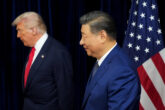June 27, 2022
Building a Silicon Bulwark: How the United States and Taiwan Can Retain Joint Leadership of the Global Semiconductor Industry
In March of this year, the Taiwan Ministry of Justice’s Investigation Bureau (法務部調查局) launched probes into more than 100 companies suspected of trying to woo the island’s semiconductor engineers to work for mainland Chinese companies. Two months later, it raided the offices of 10 more semiconductor companies and summoned their owners for questioning about talent poaching.
China’s efforts to sabotage Taiwan’s chipmaking industry are not new. In 2019, for example, Taiwan’s Business Weekly reported that more than 3,000 semiconductor engineers had already departed the island for positions at mainland companies, amounting to nearly one-tenth of the roughly 30,000 Taiwanese engineers involved in semiconductor research and development (R&D). Although Chinese firms face significant barriers in various segments of the semiconductor industry, they have succeeded in amassing a wealth of intrinsic knowledge by luring not only top Taiwanese executives, but also “entire production teams on the ground.”
Given its prominent position in so many global supply chains, threats to Taiwan’s semiconductor industry are a source of international concern.
Given its prominent position in so many global supply chains, threats to Taiwan’s semiconductor industry are a source of international concern. This article argues that, despite their competing interests in some segments of the chip market, the US and Taiwanese governments share an interest in strengthening mechanisms for mutual legal assistance, harmonizing approaches to export control, and pooling investments in semiconductor fabrication.
Read the full article from The Global Taiwan Institute.
More from CNAS
-
Transatlantic Security / Technology & National Security
Look Before We Leap on Artificial IntelligenceThis article was originally published on The Dispatch. A debate about the role that artificial intelligence should and will play in society, and how it will affect humanity fo...
By Jon B. Wolfsthal
-
Technology & National Security
Caleb Withers on the Cybersecurity Frontier in the Age of AICaleb Withers, research associate at the Center for a New American Security, joins Kevin Frazier, the AI Innovation and Law Fellow at the University of Texas School of Law and...
By Caleb Withers
-
Technology & National Security
Prepared, Not ParalyzedExecutive Summary The Trump administration has embraced a pro-innovation approach to artificial intelligence (AI) policy. Its AI Action Plan, released July 2025, underscores t...
By Janet Egan, Spencer Michaels & Caleb Withers
-
Indo-Pacific Security / Technology & National Security
Sharper: Tech + ChinaRecent talks between President Donald Trump and Chinese Communist Party General Secretary Xi Jinping placed a spotlight on emerging technologies, from high-end chips to minera...
By Charles Horn & Sevi Silvia




